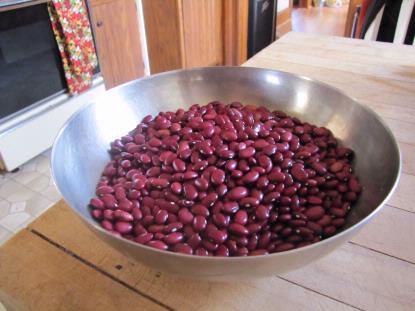Access to food or the land to grow it on has often been a weapon used to assure the poverty of a subjugated populace. Think of the Irish, the Native Americans, or the North Koreans. But we live in a time of immense surpluses of food in the developed world. We in the United States spend very little of our income on food and eat a great deal of energy intensive calories. Before cheap oil and industrial farming, no one could take food for granted as we do.
Our supermarkets are filled with fresh vegetables and fruits throughout the year. Winter produce comes from all over the world: apples from New Zealand, tomatoes from Holland and asparagus from Peru. Before the last decades of the twentieth century this abundance would have been unheard of.
For most people the year in northern climates once consisted of patterned preparation. People planted, harvested and preserved crops to make it through the winter and spring, when there was little food. Sure, there are some things that can be grown in winter. In Germany feldsalat, a small lettuce-like vegetable, is a favorite. With a little protection, carrots can be left in the ground and simple row-covers are used in Korea to protect hardy crops like cabbage through some of the cold months. These vegetables don’t usually grow when it’s that cold, but they stay good to eat. Other vegetables can safely make it through the winter in a nice root cellar: winter squash, potatoes and onions.
Not surprisingly, favorite and delicious specialties have their roots in food preservation. Milk spoils: yogurt, butter and especially cheese extend its potential for nourishment. Meat rots, so people salted, dried and smoked it; often they made it into sausages. Vegetables turn to mush but when salted, if the right bacteria cooperate they become sauerkraut, pickles, or kimchi. Failure to prepare enough food used to mean starvation.
Cheeses, pickled vegetables and preserved meats are particular to their regions. Because of the variety of climates different regions grow different foods and need to prepare for winter differently. The cheeses of Europe come from particular regions: Parma, Cheddar, or Rome. Prosciutto is a product of particularly damp and cool weather in Italy. Today, our food, like our culture, is homogenizing. Cuisine travels and we can sample what’s delicious from everywhere. This gives us fusion food, but also leads to the disappearance of what is good about regional food.
Having a diet and lifestyle that suits one’s climate means you have a better chance of living light on the land. For about 20 years now I’ve chosen to eat a vegetarian diet. I originally made this choice because I didn’t like cooking meat and I liked paddling against the current. During these two decades I’ve read some of the standard vegetarian canon: Diet for a Small Planet, John Robbins, Rachel Carson, and books by Michael Pollan. Our meat-heavy diet is bad for the planet and bad for us. Our agricultural practices are destructive to the land and put animals through unnecessary pain and suffering in order to ensure that we get hamburger for under $5 a pound.
Perhaps all of this is true, but what I have overlooked is that meat can be healthy for people. Animals can also be a part of a well run agriculture. What has gotten me thinking about eating animals most is winter time. Animals convert inedible cellulose into food we can eat. Chickens give us eggs and cows give us milk, but their meat is also nutritious and, I’ve been told, quite tasty. In a climate like that of the northeast, meat makes a great deal of sense for winter food. It’s calorie dense and if preserved correctly can last a long time. Livestock can also live through cold weather. My chickens stand around in the run when the temperature is well below freezing. They don’t mind and they keep laying eggs.
I worry about becoming like the Scandinavians in Jane Smiley’s historical novel Greenlanders. These newcomers to Greenland refused to prepare for winter the way the native Skraelings did. According to Jared Diamond (in Collapse) the Europeans wouldn’t even eat fish. The winters got colder, the people back home had the plague, so the Greenlaners starved.
So I’ve started to experiment this winter. I don’t have beef cattle, but I’ve tried a few sausages. Mostly they strike me as having an odd texture. I want to do this because I’d like to eat regionally all year round rather than just at harvest time. If I really want to live and eat sustainably, I must re-evaluate some of my habits.
More importantly, I think we all need to re-evaluate some of our eating habits as the planet warms and the last of the oil runs out. Otherwise we could be like the Greenlanders, or the inhabitants of Easter Island after they’d cut down their last tree.

Photo: Kidney beans from the author’s garden. Harvested in August and ready for cooking in January.


